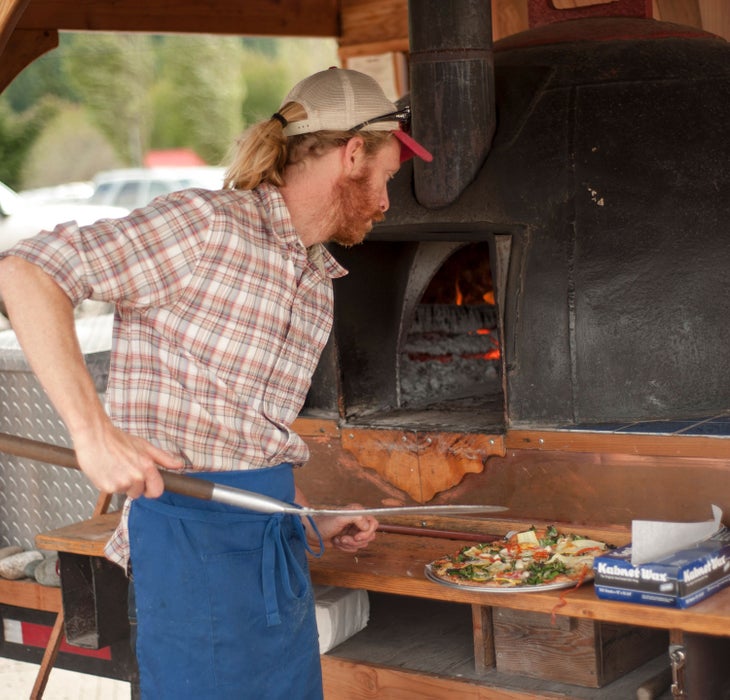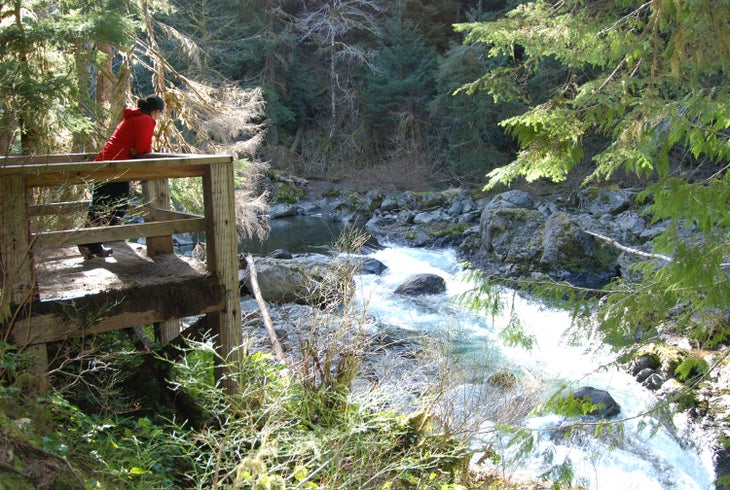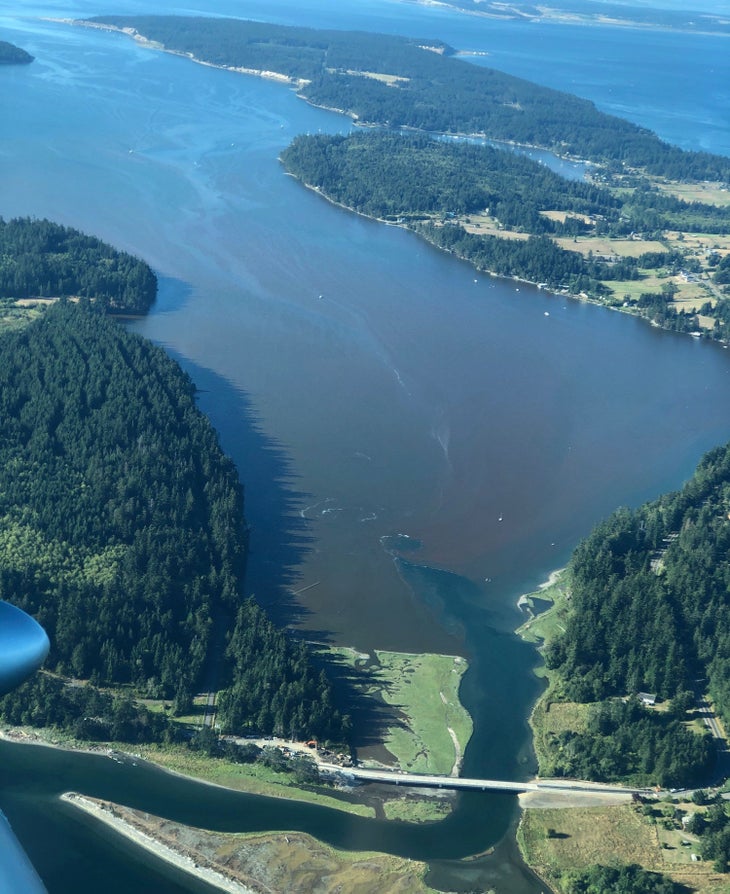Learn About Salmon Habitat at a Farm Tour and Riverside Overlook
Salmon. Revered by everyone in the Pacific Northwest from the tribes who have called this area home for time immemorial to wildlife like bears and eagles to fishermen to tourists, salmon are a vital part of the Olympic Peninsula.
Start learning about salmon at one of the many eateries around the Olympic Peninsula. At the elegant Finistère (www.restaurantfinistere.com) in Port Townsend, you can dine on salmon with farro and sweet corn. Or, you can head out to the western coast and enjoy a salmon Cesar salad or sockeye salmon sandwich at Kalaloch Lodge’s Creekside Restaurant (www.thekalalochlodge.com) for lunch.
But to really understand salmon on the peninsula, visit to Finnriver Farm & Cidery (www.finnriver.com) in Chimacum. While the main draw of Finnriver is its hard cider, the entire farm is a crash course on how humans interact with an environment. You’ll have time to visit the gift store, take in live music on the patio and enjoy a dozen oysters or a wood-fired pizza with a pint of cider in a bit, but before you get too comfortable, you’ll want to get a lay of the land.

The Salmon Coalition is one of 14 community-based nonprofits called Regional Fisheries Enhancement Groups in Washington focusing on salmon habitat restoration and education. Its mission is incredibly important as salmon in the Pacific Northwest have faced some serious adversity over the last century.
Salmon’s Role in the Olympic Peninsula’s Ecosystem
The salmon of the Olympic Peninsula are a rugged yet fragile group of anadromous fish. The largest of the Olympic salmon species, the Chinook, can grow up to five feet long and weigh up to 126 pounds. They spend most of their lives in the Pacific Ocean, thriving on an abundance of food and nutrients. When salmon are ready to spawn, or reproduce, they swim from the ocean upstream to rivers to lay their eggs away from predators.
Female salmon swim tens to hundreds of miles fighting currents and rapids to reproduce. They require a very specific type of riverbed to lay their eggs in and most salmon return to the place where they hatched, guided by smell and the earth’s magnetic field, according to the U.S. Geological Survey, to spawn.
Female salmon die shortly after laying their eggs because of the long and arduous journey. That means a female salmon gets one shot at reproducing. More than 130 species feed on their bodies, either as their major food source, or a source of sustenance when other food is scarce. Bears, otters, eagles and more often depend on salmon to survive.
The tribes of the Olympic Peninsula have also long relied on salmon as for both sustenance and as an important part of their culture. From health outcomes to economics to spirituality, salmon are intricately woven into the lives of tribes across the peninsula like the Lower Elwha Klallam.
Stop at the Sol Duc River Salmon Cascades Overlook in Fall and Spring
Salmon, trout, and steelhead are born in the Sol Duc River, but spend most of their lives in the Pacific Ocean before returning to spawn. Chinook and coho salmon ascend the Sol Duc in late summer and spawn in late fall, while cutthroat trout and steelhead run in the fall and winter and spawn into the spring. The salmon actually smell their way upstream, in search of the same waters where they hatched from the gravel a few years before. On the way to Sol Duc Hot Springs, Pull over to stand on the riverside platform to watch the fish leap the Salmon Cascades in season.

The Future of Salmon Habitat Restoration
The Elwha Restoration Project is a success story that’s well-known, but there is still much work to be done across the peninsula to ensure that salmon species like the Chinook have a future in Washington’s waters.
That’s where the Salmon Coalition comes in. Its work focuses on the waters across the Strait of San Juan de Fuca, helping make the waterways more hospitable for salmon and in turn, other species as well.
The organization does this through a variety of methods from volunteer-led planting days to large earth-moving projects with local contractors and partnerships with local schools. All of this work is done in tandem with the local community like the tribes that call the peninsula home, cities, counties and more.
One of the biggest successes the Salmon Coalition has had according to education and outreach associate, Lexi Wagor, was the Kilisut Harbor Restoration Project. Historically, Kilisut Harbor south of Port Townsend was connected to Oak Bay through a large tidal channel and salt marsh, allowing water and sediment to move freely and making it a perfect spot for juvenile salmon to migrate. A causeway was built in the 1940s, making it easier for humans to travel between Indian and Marrowstone islands. However, this choked the flow of water between the two areas.
“The causeway only had two culverts,” Wagor explains. “It was like trying to force millions of gallons of tidal water through a straw.”
Tidal water trickled through the culverts, sand stopped moving and the channel became a sand dune. Without cold water flushing into Kilisut Harbor every day, the traditionally cold waters of Kilisut Harbor heated up. Without the tidal flushing, algal blooms like the dreaded red tide became more frequent, killing off plants and wildlife.
The restoration project replaced the earthen causeway with a bridge that was safer for cars and bikes and also returned the tidal flushing to the harbor in August 2020. This passageway is also strategic for salmon as it’s located opposite of a shipping lane, making it a safer passage for young fish to get to the Pacific Ocean.
“I didn’t expect to see how quickly it made a difference,” Wagor reflects. “Standing on the bridge you can see huge schools of bait fish. The small salmon can now access Kilisut Harbor’s extensive eel grass beds and shallow waters to feed and grow. There’s even people catching cutthroat trout in the channel now.”
The below photo makes it obvious what an impact the tidal flushing has had on the harbor.

Robert Elofson from the Lower Elwha Tribe acknowledges that salmon habitat restoration still has a long way to go on the Olympic Peninsula, but he’s hopeful. A videographer who documented the Elwha Dam Restoration Project told Elofson that he could see the difference in the tribe’s demeanor as the salmon returned to the river.
“We’re nothing but all smiles now,” Elofson reflects. “We’ve not even seen the large returns yet. I can’t imagine seeing them in five to 10 years.”
